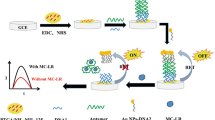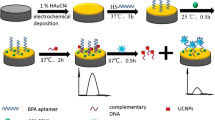Abstract
The combination of localized surface plasmon resonance (LSPR) and electrochemiluminescence (ECL) can be an effective way to amplify the signal intensity. In this work, an ECL aptasensor with 3,4,9,10-perylenetetracarboxylic acid–decorated cobalt phosphate (denoted as PTCA/CoP) as the ECL emitter and Au nanoparticles (NPs) as plasma was proposed for diclofenac assay. The prepared PTCA/CoP with special 1D/2D structure exhibited good ability and excellent ECL performance. The diclofenac aptamer acted as a bridge to link the PTCA/CoP and Au NPs; thus, the ECL performance of PTCA/CoP was greatly improved due to the plasma effect of Au NPs. Besides, it was found that the ECL signal of the aptasensor was obviously quenched by the introduction of diclofenac, which might be due to the transformation from the LSPR process to the resonance energy transform (RET) process. Under optimal conditions, the difference of ECL intensity was negatively correlated with the concentration of diclofenac in the range 0.1 pM to 10 μM with a low detection limit of 0.072 pM at the potential of −1.8 V vs. Ag/AgCl (S/N = 3). The aptasensor was proved to be suitable for the detection of diclofenac in real samples, suggesting its great practicability.
Graphical abstract








Similar content being viewed by others
References
Gao W, Saqib M, Qi L, Zhang W, Xu G (2017) Recent advances in electrochemiluminescence devices for point-of-care testing. Curr Opin Electrochem 3(1):4–10. https://doi.org/10.1016/j.coelec.2017.03.003
Kerr E, Farr R, Doeven EH, Nai YH, Alexander R, Guijt RM, Prieto-Simon B, Francis PS, Dearnley M, Hayne DJ, Henderson LC, Voelcker NH (2021) Amplification-free electrochemiluminescence molecular beacon-based microRNA sensing using a mobile phone for detection. Sensors Actuators B Chem 330:129261. https://doi.org/10.1016/j.snb.2020.129261
Mohammadzadeh-Asl S, Keshtkar A, Ezzati Nazhad Dolatabadi J, de la Guardia M (2018) Nanomaterials and phase sensitive based signal enhancement in surface plasmon resonance. Biosens Bioelectron 110:118–131. https://doi.org/10.1016/j.bios.2018.03.051
Guo C, Su F, Song Y, Hu B, Wang M, He L, Peng D, Zhang Z (2017) Aptamer-templated silver nanoclusters embedded in zirconium metal–organic framework for bifunctional electrochemical and SPR aptasensors toward carcinoembryonic antigen. ACS Appl Mater Interfaces 9(47):41188–41199. https://doi.org/10.1021/acsami.7b14952
Liu Y, Nie Y, Wang M, Zhang Q, Ma Q (2020) Distance-dependent plasmon-enhanced electrochemiluminescence biosensor based on MoS2 nanosheets. Biosens Bioelectron 148:111823. https://doi.org/10.1016/j.bios.2019.111823
Feng X, Han T, Xiong Y, Wang S, Dai T, Chen J, Zhang X, Wang G (2019) Plasmon-enhanced electrochemiluminescence of silver nanoclusters for microRNA detection. ACS Sensors 4(6):1633–1640. https://doi.org/10.1021/acssensors.9b00413
Wang S, Dong Y, Liang X (2018) Development of a SPR aptasensor containing oriented aptamer for direct capture and detection of tetracycline in multiple honey samples. Biosens Bioelectron 109:1–7. https://doi.org/10.1016/j.bios.2018.02.051
Albanese CM, Suttapitugsakul S, Perati S, McGown LB (2018) A genome-inspired, reverse selection approach to aptamer discovery. Talanta 177:150–156. https://doi.org/10.1016/j.talanta.2017.08.093
Nodehi M, Baghayeri M, Behazin R, Veisi H (2021) Electrochemical aptasensor of bisphenol A constructed based on 3D mesoporous structural SBA-15-Met with a thin layer of gold nanoparticles. Microchem J 162:105825. https://doi.org/10.1016/j.microc.2020.105825
Wu D, Sui Q, Yu X, Zhao W, Li Q, Fatta-Kassinos D, Lyu S (2021) Identification of indicator PPCPs in landfill leachates and livestock wastewaters using multi-residue analysis of 70 PPCPs: analytical method development and application in Yangtze River Delta, China. Sci Total Environ 753:141653. https://doi.org/10.1016/j.scitotenv.2020.141653
Yang L, Wang T, Zhou Y, Shi B, Bi R, Meng J (2021) Contamination, source and potential risks of pharmaceuticals and personal products (PPCPs) in Baiyangdian Basin, an intensive human intervention area, China. Sci Total Environ 760:144080. https://doi.org/10.1016/j.scitotenv.2020.144080
Chen S, Xie J, Wen Z (2020) Removal of pharmaceutical and personal care products (PPCPs) from waterbody using a revolving algal biofilm (RAB) reactor. J Hazard Mater 406:124284. https://doi.org/10.1016/j.jhazmat.2020.124284
Penha LCC, Rola RC, Martinez CBR, Martins CMG (2021) Effects of anti-inflammatory diclofenac assessed by toxicity tests and biomarkers in adults and larvae of Danio rerio. Comp Biochem Physiol C: Pharmacol Toxicol 242:108955. https://doi.org/10.1016/j.cbpc.2020.108955
Guiloski IC, Stein Piancini LD, Dagostim AC, de Morais Calado SL, Fávaro LF, Boschen SL, Cestari MM, da Cunha C, Silva de Assis HC (2017) Effects of environmentally relevant concentrations of the anti-inflammatory drug diclofenac in freshwater fish Rhamdia quelen. Ecotoxicol Environ Saf 139:291–300. https://doi.org/10.1016/j.ecoenv.2017.01.053
Efosa NJ, Kleiner W, Kloas W, Hoffmann F (2017) Diclofenac can exhibit estrogenic modes of action in male Xenopus laevis, and affects the hypothalamus-pituitary-gonad axis and mating vocalizations. Chemosphere 173:69–77. https://doi.org/10.1016/j.chemosphere.2017.01.030
Arvand M, Gholizadeh TM, Zanjanchi MA (2012) MWCNTs/Cu(OH)2 nanoparticles/IL nanocomposite modified glassy carbon electrode as a voltammetric sensor for determination of the non-steroidal anti-inflammatory drug diclofenac. Mater Sci Eng 32(6):1682–1689. https://doi.org/10.1016/j.msec.2012.04.066
Jin W, Zhang J (2000) Determination of diclofenac sodium by capillary zone electrophoresis with electrochemical detection. J Chromatogr A 868(1):101–107. https://doi.org/10.1016/S0021-9673(99)01149-8
Hájková R, Solich P, Pospišilová M, Šicha J (2002) Simultaneous determination of methylparaben, propylparaben, sodium diclofenac and its degradation product in a topical emulgel by reversed-phase liquid chromatography. Anal Chim Acta 467(1):91–96. https://doi.org/10.1016/S0003-2670(02)00131-9
Shishov A, Nechaeva D, Bulatov A (2019) HPLC-MS/MS determination of non-steroidal anti-inflammatory drugs in bovine milk based on simultaneous deep eutectic solvents formation and its solidification. Microchem J 150:104080. https://doi.org/10.1016/j.microc.2019.104080
Mlunguza NY, Ncube S, Mahlambi PN, Chimuka L, Madikizela LM (2020) Optimization and application of hollow fiber liquid-phase microextraction and microwave-assisted extraction for the analysis of non-steroidal anti-inflammatory drugs in aqueous and plant samples. Environ Monit Assess 192(8):557. https://doi.org/10.1007/s10661-020-08527-4
Li J, Jiang D, Shan X, Wang W, Chen Z (2020) An “off-on” electrochemiluminescence aptasensor for microcystin-LR assay based on the resonance energy transfer from PTCA/NH2-MIL-125(Ti) to gold nanoparticles. Microchim Acta 187(8):474. https://doi.org/10.1007/s00604-020-04453-x
Srinivas S, Ch. Venkata R, Kakarla RR, Shetti NP, Reddy MS, Anjanapura VR (2019) Novel Co and Ni metal nanostructures as efficient photocatalysts for photodegradation of organic dyes. Mater Res Express 6(12):125502. https://doi.org/10.1088/2053-1591/ab5328
Kannan K, Radhika D, Nesaraj AS, Kumar Sadasivuni K, Reddy KR, Kasai D, Raghu AV (2020) Photocatalytic, antibacterial and electrochemical properties of novel rare earth metal oxides-based nanohybrids. Mater Sci Energy Technol 3:853–861. https://doi.org/10.1016/j.mset.2020.10.008
Song X, Shao X, Dai L, Fan D, Ren X, Sun X, Luo C, Wei Q (2020) Triple amplification of 3,4,9,10-perylenetetracarboxylic acid by Co(2+)-based metal-organic frameworks and silver-cysteine and its potential application for ultrasensitive assay of procalcitonin. ACS Appl Mater Interfaces 12(8):9098–9106. https://doi.org/10.1021/acsami.9b23248
Shi T, Wen Z, Ding L, Liu Q, Guo Y, Ding C, Wang K (2019) Visible/near-infrared light response VOPc/carbon nitride nanocomposites: VOPc sensitizing carbon nitride to improve photo-to-current conversion efficiency for fabricating photoelectrochemical diclofenac aptasensor. Sensors Actuators B Chem 299:126834. https://doi.org/10.1016/j.snb.2019.126834
Li J, Shan X, Jiang D, Chen Z (2020) An ultrasensitive electrochemiluminescence aptasensor for the detection of diethylstilbestrol based on the enhancing mechanism of the metal–organic framework NH2-MIL-125(Ti) in a 3,4,9,10-perylenetetracarboxylic acid/K2S2O8 system. Analyst 145(9):3306–3312. https://doi.org/10.1039/D0AN00212G
Zhu D, Yan Y, Lei P, Shen B, Cheng W, Ju H, Ding S (2014) A novel electrochemical sensing strategy for rapid and ultrasensitive detection of Salmonella by rolling circle amplification and DNA–AuNPs probe. Anal Chim Acta 846:44–50. https://doi.org/10.1016/j.aca.2014.07.024
Fu X, Yang Y, Wang N, Chen S (2017) The electrochemiluminescence resonance energy transfer between Fe-MIL-88 metal–organic framework and 3, 4, 9, 10-perylenetetracar-boxylic acid for dopamine sensing. Sensors Actuators B Chem 250:584–590. https://doi.org/10.1016/j.snb.2017.04.054
Peng H, Huang Z, Wu W, Liu M, Huang K, Yang Y, Deng H, Xia X, Chen W (2019) Versatile high-performance electrochemiluminescence ELISA platform based on a gold nanocluster probe. ACS Appl Mater Interfaces 11(27):24812–24819. https://doi.org/10.1021/acsami.9b08819
Prabhu R, Roopashree B, Jeevananda T, Rao S, Raghava Reddy K, Raghu AV (2021) Synthesis and corrosion resistance properties of novel conjugated polymer-Cu2Cl4L3 composites. Mater Sci for Energy Technol 4:92–99. https://doi.org/10.1016/j.mset.2021.01.001
Huang L, Shen R, Liu R, Xu S, Shuai Q (2021) Facile fabrication of magnetic covalent organic frameworks for magnetic solid-phase extraction of diclofenac sodium in milk. Food Chem 347:129002. https://doi.org/10.1016/j.foodchem.2021.129002
Giagoudakis G, Markantonis SL (1998) An alternative high-performance liquid-chromatographic method for the determination of diclofenac and flurbiprofen in plasma. J Pharmaceut Biomed 17(4):897–901. https://doi.org/10.1016/S0731-7085(97)00258-6
Ensafi AA, Izadi M, Karimi-Maleh H (2013) Sensitive voltammetric determination of diclofenac using room-temperature ionic liquid-modified carbon nanotubes paste electrode. Ionics 19(1):137–144. https://doi.org/10.1007/s11581-012-0705-0
Okoth OK, Yan K, Feng J, Zhang J (2018) Label-free photoelectrochemical aptasensing of diclofenac based on gold nanoparticles and graphene-doped CdS. Sensors Actuators B Chem 256:334–341. https://doi.org/10.1016/j.snb.2017.10.089
Derikvand H, Roushani M, Abbasi AR, Derikvand Z, Azadbakht A (2016) Design of folding-based impedimetric aptasensor for determination of the nonsteroidal anti-inflammatory drug. Anal Biochem 513:77–86. https://doi.org/10.1016/j.ab.2016.06.013
Kashefi-Kheyrabadi L, Mehrgardi MA (2012) Design and construction of a label free aptasensor for electrochemical detection of sodium diclofenac. Biosens Bioelectron 33(1):184–189. https://doi.org/10.1016/j.bios.2011.12.050
Wang C, Jiang T, Zhao K, Deng A, Li J (2019) A novel electrochemiluminescent immunoassay for diclofenac using conductive polymer functionalized graphene oxide as labels and gold nanorods as signal enhancers. Talanta 193:184–191. https://doi.org/10.1016/j.talanta.2018.09.103
Funding
We are very grateful for the support from the Natural Science Foundation of Jiangsu Province (BK20190928), the Natural Science Foundation of the Jiangsu Higher Education Institutions of China (19KJB150003), the National Natural Science Foundation of China (51874050, 21904014), the Foundation of Jiangsu Key Laboratory of Advanced Catalytic Materials and Technology (BM2012110), and the Foundation of the Science and Technology Bureau of Changzhou Province (CQ20204033).
Author information
Authors and Affiliations
Corresponding author
Ethics declarations
Conflict of interest
The authors declare no competing interests.
Additional information
Publisher’s note
Springer Nature remains neutral with regard to jurisdictional claims in published maps and institutional affiliations.
Supplementary information
The following is the Supplementary data to this article:
ESM 1
(DOCX 944 kb)
Rights and permissions
About this article
Cite this article
Li, J., Shan, X., Jiang, D. et al. Au nanoparticle plasmon-enhanced electrochemiluminescence aptasensor based on the 1D/2D PTCA/CoP for diclofenac assay. Microchim Acta 188, 231 (2021). https://doi.org/10.1007/s00604-021-04879-x
Received:
Accepted:
Published:
DOI: https://doi.org/10.1007/s00604-021-04879-x




